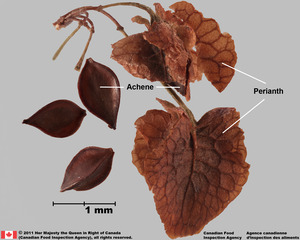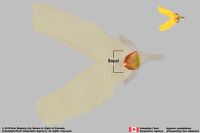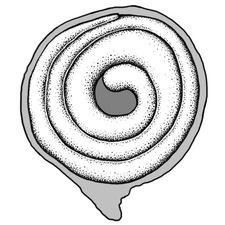Content is from Kirkbride et al. 2006Kirkbride et al. 2006:
Kirkbride JH, Jr, Gunn CR, and Dallwitz MJ. 2006. Family guide for fruits and seeds, vers. 1.0. Accessed September 2020-January 2022. URL: https://nt.ars-grin.gov/seedsfruits/keys/frsdfam/index.cfm ., without modification.
Updates are forthcoming.
Fruits: Pistil(s) simple, or compound; 1; 1-pistillate; with carpels united. Fruit anthocarpanthocarp:
simple or compound and including some tissue of non-ovarian origin (accessory tissue) ; simple; acrosarcum (Basella alba L.), or diclesium (Ullucus tuberosus Caldas); without persistent central column; within accessory organ(s); within perianthperianth:
; simple; acrosarcum (Basella alba L.), or diclesium (Ullucus tuberosus Caldas); without persistent central column; within accessory organ(s); within perianthperianth:
collective term for calyx and corolla of a flower
 (Basella alba L.), or sepalssepal:
(Basella alba L.), or sepalssepal:
a member of the outer envelope of a flower (calyx) (Ullucus tuberosa Caldas with drawings & of Anredea); with 3-carpellate (becoming at maturity 1-carpeled with 1 seed); with carpels united; with carpels remaining united at maturity; without sterilesterile:
(Ullucus tuberosa Caldas with drawings & of Anredea); with 3-carpellate (becoming at maturity 1-carpeled with 1 seed); with carpels united; with carpels remaining united at maturity; without sterilesterile:
lacking male and/or female reproductive parts; also, not producing fruit or seed
 carpels; not sulcatesulcate:
carpels; not sulcatesulcate:
surface relief—having one or more elongate, relatively narrow and shallow depressions or grooves ; apexapex:
; apexapex:
the point farthest from the point of attachment, or the "tip" of an organ not beaked; indehiscentindehiscent:
not beaked; indehiscentindehiscent:
not opening on its own, as in a fruit
 . Epicarpepicarp:
. Epicarpepicarp:
outer layer of fruit wall or pericarp, if divided into layers; note here used synonymously with exocarp durable; without armature; with wing(s), or without wing(s); 2-winged (Anredera); with wing(s) laterallateral:
durable; without armature; with wing(s), or without wing(s); 2-winged (Anredera); with wing(s) laterallateral:
(of embryo) embryo lies along the side of the seed, generally towards one end; of, at, or from the side; in grasses, can refer to the sides adjacent to the dorsal and ventral sides
; without apicalapical:
at or pertaining to the end of the seed or fruit distal from its point of attachment (i.e., base)
respiratory hole. Endocarpendocarp:
the inner layer of the pericarp, if divided into layers absent. Funiculusfuniculus:
absent. Funiculusfuniculus:
(alt. funicle) stalk connecting the ovule (later seed) to the ovary (later fruit) placenta short; short without seed bearing hookswith hooks:
short; short without seed bearing hookswith hooks:
bristles or spines with curved or backwards pointing tips, or with secondary bristles along their length (retinacula); not persisting in fruit after seed shed.
(retinacula); not persisting in fruit after seed shed.
Seeds: Arilaril:
(broad sense) appendicular structure that wholly or partly envelops a seed and is produced from or a modification of the funicle, raphe, or outer integument; usually fleshy or pulpy, sometimes spongy or tufted-capillate, often brightly colored absent. Seed larger than minute; circularcircular:
absent. Seed larger than minute; circularcircular:
(of embryo) linear embryo is curved into an "O" shape ; terete; not bowl shaped; not nutlike; without winglike beakbeak:
; terete; not bowl shaped; not nutlike; without winglike beakbeak:
a usually firm, terminal appendage, sometimes tapered ; without caudatecaudate:
; without caudatecaudate:
tapering to a long, tail-like appendage appendage(s); at maturity with food reserves; with perispermperisperm:
appendage(s); at maturity with food reserves; with perispermperisperm:
seed nutritive tissue comparable to the endosperm, but derived from the nucellus (maternal tissue)
, or endosperm; without canavanine. Sarcotestasarcotesta:
pulpy or fleshy outer layer of the seed coat, simulates aril absent. Testatesta:
absent. Testatesta:
seed coat
 present; without fleshy or leatheryleathery:
present; without fleshy or leatheryleathery:
texture—moderately thick, tough, and very pliable
layer over hard layer; without glands; without bristles; without wings; without collar; without operculumoperculum:
a dehiscent cap (or lid) of a seed or fruit that opens during germination or dehiscence ; colored; monochrome; membranousmembranous:
; colored; monochrome; membranousmembranous:
texture—extremely thin, pliable, and fairly tough
; not becoming mucilaginousmucilaginous:
resembling mucilage; moist and sticky
when wetted; surrounding embryo. Rapheraphe:
a ridge or seam on the seed coat, formed by the portion of the funiculus united to the ovule wall in longitudinally curved ovules inconspicuous. Endosperm development nuclear. Perispermperisperm:
inconspicuous. Endosperm development nuclear. Perispermperisperm:
seed nutritive tissue comparable to the endosperm, but derived from the nucellus (maternal tissue)
copious, or scanty (Basella with coiledcoiled:
(of embryo) linear embryo is very long and bent to form a coil whereby one end of the embryo is on the outside and the other end near the middle of the seed embryo); with starch; with starch composed of clustered grains; opaqueopaque:
embryo); with starch; with starch composed of clustered grains; opaqueopaque:
not transmitting light
. Embryo differentiated from food reserve; well developed; 1 per seed; partially filling testatesta:
seed coat
 (with food reserve); at one end of seed not extending into a depression or cup; peripheralperipheral:
(with food reserve); at one end of seed not extending into a depression or cup; peripheralperipheral:
(of embryo) embryo is curved around the outer edge of the seed, near the seed coat
; flatly coiledcoiled:
(of embryo) linear embryo is very long and bent to form a coil whereby one end of the embryo is on the outside and the other end near the middle of the seed (circinatecircinate:
(circinatecircinate:
3D shape—terete and rolled downward from the apex in a tight coil
), or annularannular:
3D shape—forming a ring ; 90% annularannular:
; 90% annularannular:
3D shape—forming a ring , or 100% annularannular:
, or 100% annularannular:
3D shape—forming a ring , or 150% annularannular:
, or 150% annularannular:
3D shape—forming a ring ; with cotyledons gradually connected to hypocotyl-radicle; without coleorhiza; without simmondsin; without stomata; not green; with 2 or more cotyledons. Cotyledons 2; well developed; 0.5–0.7 times length of embryo; not concealing hypocotyl-radicle; foliaceous; moderately thick; circinatecircinate:
; with cotyledons gradually connected to hypocotyl-radicle; without coleorhiza; without simmondsin; without stomata; not green; with 2 or more cotyledons. Cotyledons 2; well developed; 0.5–0.7 times length of embryo; not concealing hypocotyl-radicle; foliaceous; moderately thick; circinatecircinate:
3D shape—terete and rolled downward from the apex in a tight coil
; smooth; with apicesapex:
the point farthest from the point of attachment, or the "tip" of an organ entire; with margins separate; basally entire; equal in size; not punctatepunctate:
entire; with margins separate; basally entire; equal in size; not punctatepunctate:
surface relief—dotted with pits or with translucent, sunken glands or with colored dots, similar to pitted dotted. Hypocotyl-radicle well developed; coiledcoiled:
dotted. Hypocotyl-radicle well developed; coiledcoiled:
(of embryo) linear embryo is very long and bent to form a coil whereby one end of the embryo is on the outside and the other end near the middle of the seed ; not thickened.
; not thickened.
General references: Cronquist, A. 1981. An integrated system of classification of flowering plants, 1,262 p. Columbia University Press, New York, Goldberg, A. 1986 (dicots) & 1989 (monocots). Classification, evolution, and phylogeny of the familes of Dicotyledons. Smithsonian Contr. Bot. 58 for dicots (314 pp.) & 71 for monocots (74 pp.). [Goldberg's illustrations are reproduced from older publications and these should be consulted], Gunn, C.R. & C.A. Ritchie. 1988. Identification of disseminulesdisseminule:
detachable plant part capable of being disseminated and of propagating, commonly a seed or fruit
listed in the Federal Noxious Weed Act. Techn. Bull. U.S.D.A. 1719:1–313, Gunn, C.R., J.H. Wiersema, C.A. Ritchie, & J.H. Kirkbride, Jr. 1992 & amendments. Families and genera of Spermatophytes recognized by the Agricultural Research Service. Techn. Bull. U.S.D.A. 1796:1–500, Mabberley, D.J. 1987. The plant-book, 706 p. Cambridge University Press, Cambridge, and Spjut, R.W. 1994. A systematic treatment of fruit types. Mem. New York Bot. Gard. 70:1–182.